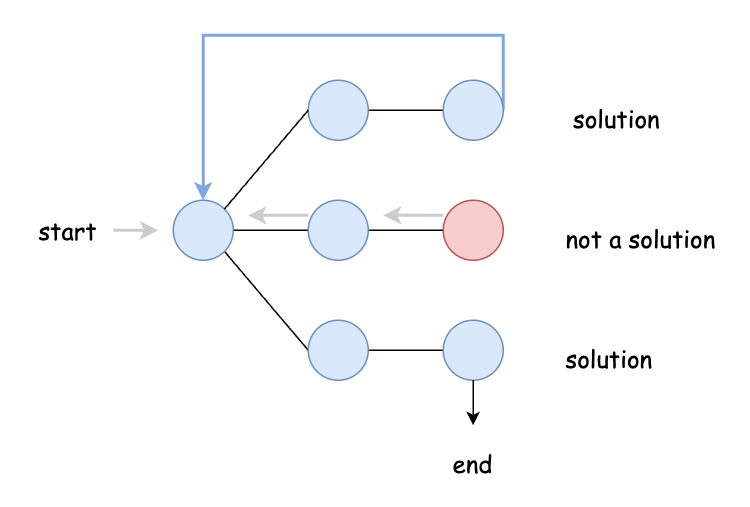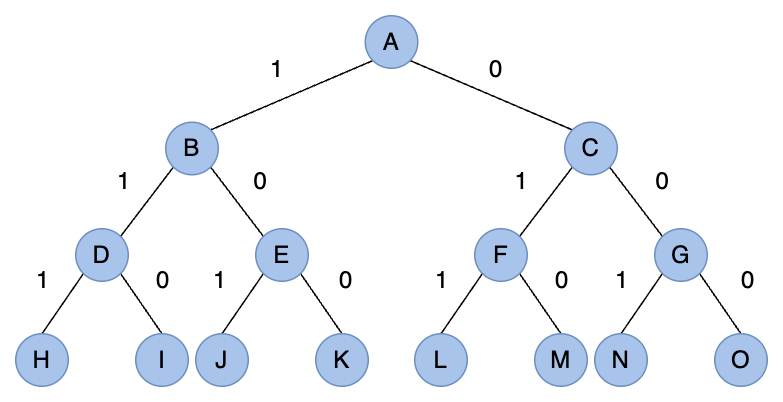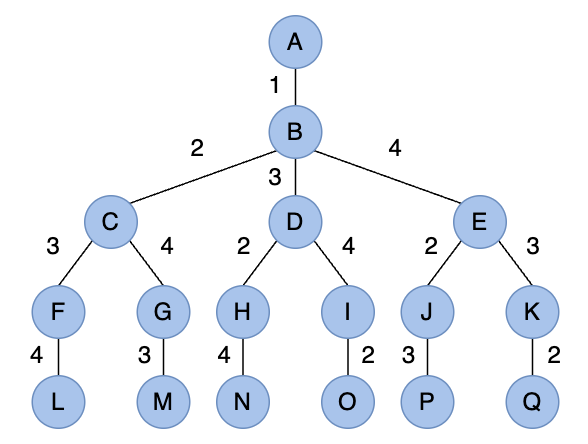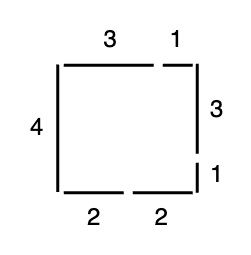本文同步更新於個人網站中,有更好的排版和程式碼區塊 highlighting 支援。
回溯法(backtracking)是一種在某個集合求其子集或特定排列的特殊解法。它沒有對應的資料結構,但其在求解的過程是固定的,它的核心思想是從一個初始狀態開始,暴力搜尋所有可能的解,如果發現不是正確的解,就回溯到上一步,再繼續搜尋,直到找到正確的解或是所有可能的解都已經試過為止。我們這裡所說的集合,通常是指二維陣列、多維陣列或是字串,我們需要從中找到一些符合條件的元素放到結果集中,這是一個嘗試或者說試探的過程。而試探,就會有失敗的情況,如何做到只改些許參數,就能夠繼續試探是非常重要的課題。
我們通常會採用深度優先搜尋(DFS)來遍歷解空間,在介紹二元樹的前、中、後序走訪時也是使用 DFS,因此我們會借助遞迴來完成我們的回溯法。

backtracking 由兩個部分組成:入口函式和遞迴函式(backtrack)。
入口函式分成幾個部分,首先是對參數的簡單判斷,如果不符合條件,立即回傳空結果集。其次是變數的集中定義區域,結果集與候選集(candidates)就是定義在這裡;通常還會對目前集合進行排序,提升程式的效能;如果要對結果進行去重,去重用的 hash 也會放在這裡。然後是呼叫遞迴函式,最後回傳結果集。
遞迴函式一般命名為 backtrack,它分成兩部分,一個是終止條件,應該放在最前面,用於將 candidate 複製一份加入結果集中。為什麼要複製呢?因為我們的結果集通常是一個二維陣列,而 candidate 在遞迴過程滿足特定條件會增加新元素,因此這不能是一個全新的空 candidate。candidate 都是基於某一個有效的 candidate 進行修改(回溯)的。再來談終止條件,它可能是 candidate 的長度是否達到某個臨界值,或者是否已經到達最後一個元素。遞迴函式的第二個部分是進行 for 迴圈,跑迴圈的過程中要收集元素到 candidate,呼叫遞迴函式,因為迴圈過程中的參數是不斷變化的,這樣我們就實現了類似窮舉的效果。在呼叫完遞迴函式後,記得要將一些中間變數還原,變數還原就是回溯的真諦。
當所給問題是從 n 個元素的集合 S 中找出滿足某個性質的子集時,對應的解空間樹稱為子集樹。例如 n 個物品的 0/1 背包問題(如下圖)所對應的解空間樹是一棵子集樹,這類子集樹通常有 個葉節點,節點總數為
。遍歷子集樹的演算法需要
的時間。

當所給問題是確定滿足某種性質的 n 個元素排列時,對應的解空間樹稱為排列樹。例如旅行推銷員問題(如下圖)的解空間樹是一棵排列樹,這類排列樹通常有 個葉節點。遍歷子集樹的演算法需要
的時間。

backtracking 的 pseudocode 如下:
// 子集樹
function main(set, 其他參數) {
if (如果 set 不合法或長度為零,或其他參數明顯有問題) {
return 簡單結果;
}
set.sort(); // 排序提升效率
let result = [], candidate = [], end = nums.length;
function backtrack(start, 其他參數) {
if (start === end) { // 或其他情況
// 這裡可能還有其他條件
result.push([...candidate]); // 將候選集複製一份加入結果集
} else {
// 注意,如果限定子集數量需要改動一下
for (let i = start; i < end; i++) {
// 處理中間變數
candidate.push(陣列元素);
backtrack(i + 1, ...);
candidate.pop(); // 還原 candidate
// 還原其他中間變數
}
}
}
backtrack(0, 其他參數);
return result;
}
// 排列樹
function main(set, 其他參數) {
if (如果 set 不合法或長度為零,或其他參數明顯有問題) {
return [];
}
// set 不需要排序!
let result = [], candidate = [], end = nums.length, hash = {};
// hash 是用來實現排序效果的
function backtrack(start, 其他參數) {
if (start === end) { // 或其他情況
// 這裡可能還有其他條件
result.push([...candidate]);
return;
}
for (let i = 0; i < end; i++) {
// 處理中間變數
if (!hash[i]) {
hash[i] = true;
candidate.push(陣列元素);
backtrack(start + 1, ...);
candidate.pop(); // 還原 candidate
hash[i] = false;
// 還原其他中間變數
}
}
}
backtrack(0, 其他參數);
return result;
}
子集問題的相關例題包括沒重複元素的子集問題、有重複元素的子集問題、有重複元素的組合總和、背包問題、裝載問題和火柴棒問題等。
這是 LeetCode 78. Subsets 的原題,給定一個不包含重複元素的整數陣列 nums,回傳該陣列所有可能的子集(幂集)。注意:結果集不能包含重複的子集。
Example 1:
Input: nums = [1,2,3]
Output: [[],[1],[2],[1,2],[3],[1,3],[2,3],[1,2,3]]
Example 2:
Input: nums = [0]
Output: [[],[0]]
思路:我們根據上面的 pseudocode 來實現,首先是入口函式的第一部分,怎麼快速排除有問題的參數或特例。如果參數不是陣列或是它的長度為零,我們就直接回穿空陣列。然後我們宣告一個 result、candidate,排序陣列,然後呼叫遞迴函式。
接下來我們看一下終止條件,因為子集可以為空,也就是說任何情況 candidate 都可以放進 result。其他就與模板一致了。我們來看一下實作程式碼:
function subsets(nums) {
if (!Object(nums).length) { // 相當於 !nums || !nums.length
return [];
}
nums.sort((a, b) => a - b);
const result = [];
const candidate = [];
const end = nums.length;
function backtrack(start) {
result.push([...candidate]); // 沒有長度限制,直接放進 result
for (let i = start; i < end; i++) {
candidate.push(nums[i]); // 試探
backtrack(i + 1); // 修改參數
candidate.pop(); // 不管成功與否,退回上一步
}
}
backtrack(0);
return result;
}
整個探索過程如下:
| candidate | result | |
|---|---|---|
0 |
[1] |
[[], [1]] |
1 |
[1, 2] |
[[], [1], [1, 2]] |
2 |
[1, 2, 3] |
[[], [1], [1, 2], [1, 2, 3]] |
2 |
[1, 3] |
[[], [1], [1, 2], [1, 2, 3], [1, 3]] |
1 |
[2] |
[[], [1], [1, 2], [1, 2, 3], [1, 3], [2]] |
2 |
[2, 3] |
[[], [1], [1, 2], [1, 2, 3], [1, 3], [2], [2, 3]] |
2 |
[3] |
[[], [1], [1, 2], [1, 2, 3], [1, 3], [2], [2, 3], [3]] |
如果今天給定的陣列存在重複元素呢?我們再來看看 90. Subsets II 的原題,給定一個可能包含重複元素的整數陣列 nums,回傳該陣列所有可能的子集(幂集)。注意:結果集不能包含重複的子集。
Example 1:
Input: nums = [1,2,2]
Output: [[],[1],[1,2],[1,2,2],[2],[2,2]]
Example 2:
Input: nums = [0]
Output: [[],[0]]
與上一題只有一點差別,但它只是對候選集做出限制,即結果集中不能出現兩個 [1,2] 陣列。
我們可以使用 hash 來去重,實作程式碼如下:
function subsetsWithDup(nums) {
nums.sort((a, b) => a - b);
const result = [];
const candidate = [];
const end = nums.length;
const hash = new Map();
function backtrack(start) {
const candidateKey = candidate.toString();
if (!hash.get(candidateKey)) { // 去除重複
result.push([...candidate]);
hash.set(candidateKey, true);
}
for (let i = start; i < end; i++) {
candidate.push(nums[i]);
backtrack(i + 1);
candidate.pop();
}
}
backtrack(0);
return result;
}
當然,我們也可以在遞迴函式的 for 迴圈中加入判斷去重,有興趣的讀者可以嘗試一下。
這題是 39. Combination Sum 的原題,給定一個無重複元素的正整數陣列 candidates 和一個正整數 target,找出 candidates 中所有可以使數字之和為 target 的組合。candidates 中的數字可以無限制重複被選取。
Example 1:
Input: candidates = [2,3,6,7], target = 7
Output: [[2,2,3],[7]]
Example 2:
Input: candidates = [2,3,5], target = 8
Output: [[2,2,2,2],[2,3,3],[3,5]]
Example 3:
Input: candidates = [2], target = 1
Output: []
思路:本題更接近我們的模板,由於元素可以重複使用,我們在遞迴函式的 for 迴圈裡就不用改變 start 變數。並且我們還要計算放入候選集的元素的總和是否為 target,但總不能每次都把候選集加總一次吧,反過來,我們每次將它與新元素相減,只要結果為零,就退出遞迴。實作程式碼如下:
function combinationSum(candidates, target) {
const result = [];
const combination = [];
const end = candidates.length;
function backtrack(start, target) {
if (target === 0) { // 等於 0,退出遞迴
result.push([...combination]);
return;
}
if (target > 0) { // 大於 0,繼續新增元素
for (let i = start; i < end; i++) {
combination.push(candidates[i]);
// 注意這裡 i 沒有加 1,因為可以重複使用相同的數字
backtrack(i, target - candidates[i]);
combination.pop();
}
}
}
backtrack(0, target);
return result;
}
這題是 40. Combination Sum II 的原題,給定一個元素範圍為 1~50 的整數陣列和一個目標數字 target,找出陣列中所有可以使數字之和為 target 的組合。陣列中的每個數字只能在組合中使用一次。結果集不能包含重複的組合。
Example 1:
Input: candidates = [10,1,2,7,6,1,5], target = 8
Output: [[1,1,6],[1,2,5],[1,7],[2,6]]
Example 2:
Input: candidates = [2,5,2,1,2], target = 5
Output: [[1,2,2],[5]]
思路與上面很相似,但由於元素只使用一次,我們只要在迴圈中改變 start 的值即可。並且題目要求結果集不能包含重複的組合,解決方案一樣是使用 hash 去重。實作程式碼如下:
function combinationSum2(candidates, target) {
candidates.sort((a, b) => a - b);
const result = [];
const combination = [];
const end = candidates.length;
const hash = {};
function backtrack(start, target) {
const combinationKey = combination.toString(); // 將陣列轉為字串當作 key
if (target === 0 && !hash[combinationKey]) {
result.push([...combination]);
hash[combinationKey] = true;
return;
}
if (target > 0) {
for (let i = start; i < end; i++) {
combination.push(candidates[i]);
backtrack(i + 1, target - candidates[i]);
combination.pop();
}
}
}
backtrack(0, target);
return result;
}
給定 n 個重量為 ,價值為
的物品和一個容量為
capacity 的背包,求如何裝才能在不超過背包承重的情況下,使得背包中物品的總價值最大?
Example:
input: n = 5, [2, 2, 6, 5, 4], [6, 3, 5, 4, 6], capacity = 10
output: 15, [1, 1, 0, 0, 1] // 1 表示選取,0 表示不選取
0/1 背包問題的解題思路在於遞迴函式的 for 迴圈,其 end 變數不再是物品的數量,而是我們決策分支的數量、選還是不選。因此 end = 1(從零開始),然後我們設計一個陣列,來記錄該物品的選擇情況。由於限制條件存在兩個,首先是放進背包的總重量不能超過背包的容量,因此我們需要不斷累計這個變數。其次,當選擇最後一個物品後,我們要看物品的總價值是否比之前的還高。實作程式碼如下:
function knapsack01(n, weights, values, capacity) {
const allocation = new Array(n).fill(0); // 表示是否選中
let currValue = 0;
let currWeight = 0;
let maxValue = 0;
let maxWeight = 0;
let result = [];
function backtrack(start) {
if (start === n && currValue > maxValue) {
maxValue = currValue;
maxWeight = currWeight;
result = [...allocation];
return;
}
for (let i = 0; i < 2; i++) {
if (currWeight + i * weights[start] <= capacity) {
allocation[start] = i; // 0 為不放進包中,1 為放進包中
currWeight += i * weights[start];
currValue += i * values[start];
backtrack(start + 1);
currWeight -= i * weights[start];
currValue -= i * values[start];
}
}
}
backtrack(0);
return [maxValue, result];
}
有 n 個集裝箱要裝上兩艘輪船,兩艘輪船的載重分別為 c1 和 c2。其中每個集裝箱的重量為 [w0, w1, ..., wi],請問是否有一個合理的裝載方案,可將這 n 個集裝箱裝上兩艘輪船?
如果有,請給出一個裝載方案。
Example 1:
input: c1 = 50, c2 = 50, goods = [10, 40, 40]
output: [[10, 40], [40]]
Example 2:
input: c1 = 50, c2 = 50, goods = [20, 40, 40]
output: [[], []]
思路:這題與 0/1 背包問題很相似,只不過上一題是放到一艘船(包)上,這題是放到兩艘船上。在之前的題型中,我們不知道結果集中有多少個子陣列,現在我們明確知道有兩個,我們可以直接生成所有子陣列。然後在遞迴函式的迴圈中,根據子陣列的總和依次判定是否能繼續放東西。實作程式碼如下:
function boatLoad(c1, c2, goods) {
goods.sort();
const boats = [[], []];
const currWeight = [0, 0];
const maxWeight = [c1, c2];
function backtrack(start) {
if (start >= goods.length) {
return currWeight[0] <= maxWeight[0] && currWeight[1] <= maxWeight[1];
} else {
const weight = goods[start];
for (let i = 0; i < 2; i++) {
if (currWeight[i] + weight > maxWeight[i]) {
continue;
}
currWeight[i] += weight;
boats[i].push(weight);
if (backtrack(start + 1)) {
return true;
}
currWeight[i] -= weight;
boats[i].pop();
}
}
return false;
}
backtrack(0);
return boats;
}
給定一個整數陣列 matchsticks,裡面的數字代表該個火柴棒的長度,求解是否能將這些火柴棒拼成一個正方形?例如 [4, 3, 3, 2, 2, 1, 1] 能拼成如下圖所示的正方形:

思路:既然是正方形,那肯定有四條邊,因此陣列中的元素不能少於 4 個,且每條邊的長度必須相等,換言之,所有元素的總和必須是 4 的倍數。這樣一來我們就可以輕鬆排除一些不合法的參數。然後進入探索過程,這和裝載問題差不多,不同的是我們需要 4 個子陣列。實作程式碼如下:
function makesquare(matchsticks) {
if (matchsticks.length < 4) {
// 如果火柴棒數量小於 4,則無法構成正方形
return false;
}
const sides = [[], [], [], []]; // sides 是用來觀察每個邊的火柴棒的,可以不要有
const total = matchsticks.reduce((acc, curr) => acc + curr, 0);
if (total % 4) {
// 不能被 4 整除
return false;
}
matchsticks.sort((a, b) => b - a); // 由大到小排序
const maxSideLength = total / 4;
const currSide = [0, 0, 0, 0];
const end = matchsticks.length;
function backtrack(start) {
if (start >= end) {
return (
currSide[0] === maxSideLength &&
currSide[1] === maxSideLength &&
currSide[2] === maxSideLength &&
currSide[3] === maxSideLength
);
} else {
for (let i = 0; i < 4; i++) {
if (currSide[i] + matchsticks[start] > maxSideLength) {
continue;
}
sides[i].push(matchsticks[start]); // 這個可以不要
currSide[i] += matchsticks[start];
if (backtrack(start + 1)) {
return true;
}
sides[i].pop(); // 這個可以不要
currSide[i] -= matchsticks[start];
}
}
return false;
}
const result = backtrack(0);
console.log(JSON.stringify(sides), result);
return result;
}
我們今天認識了回溯法的基本概念,並利用模板來實際練習了很多子集相關的題目,明天還會繼續來看看排列相關的題目。
